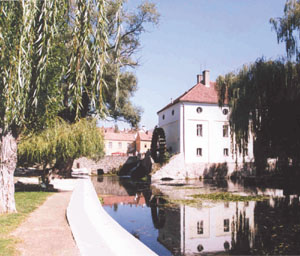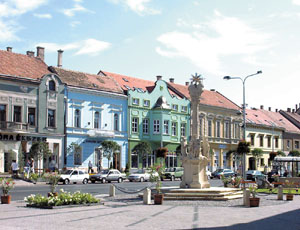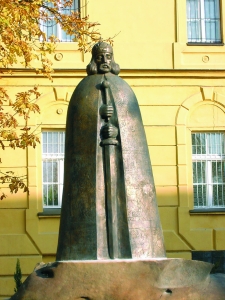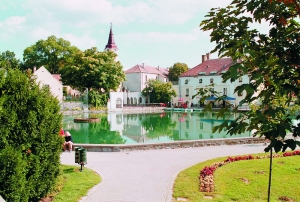The town is situated 12 km from Lake Balaton, in the basin named after it. The name refers to the thermal springs around the town, as the Slavic word 'Topulcha' means thermal water in Hungarian.
It was inhabited as early as the neolithic age. The dynamically developing small town of 20,000 inhabitants has been the regional centre since the 13th century. The inhabitants have been earning their living by growing wine with traditional methods. The wines of the region are popular all over Europe.
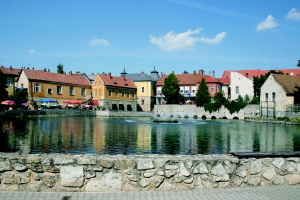 The busy commercial life in the 19th century is reflected in the townscape. As a result of the important development at the turn of the 19th and 20th centuries it has become an important transport junction in the region. Since then the places of interest in the town and in the neighbourhood have made it popular with tourists. Apart from the sights it attracts visitors with a wide variety of prgrammes from spring to autumn.
The busy commercial life in the 19th century is reflected in the townscape. As a result of the important development at the turn of the 19th and 20th centuries it has become an important transport junction in the region. Since then the places of interest in the town and in the neighbourhood have made it popular with tourists. Apart from the sights it attracts visitors with a wide variety of prgrammes from spring to autumn.
Lake Cave
The Lake Cave, which is situated in the heart of the town, is a unique attraction in Central Europe. It was found in 1903 in the course of digging a well and it was opened to the public ten years later. The three-storey cave system was created by karst water. Its lower rooms and some of the upper levels are covered with 19 °C water. This section, which is nearly 300 m long, can be visited on boats. In the clean water of varying depth you can see the passages leading to the lower rooms. The medicinal effect of the cave with a special climate has been well-known for a long time. The relatively constant (14-16 °C) temperature, the nearly 100% relative humidity and the extremely clean air is excellent for treating allergic, asthmatic and other respiratory diseases. The medical treatments are carried out in another section of the cave, in the Hospital cave, which was found in 1925.
Lake Malom
The neighbourhood of Lake Malom is a romantic part of the town with a Mediterranean atmosphere. From the main square you can get to the Great lake going through a friendly inner courtyard. At the lake you can see the statue of poet János Batsányi, who was born in Tapolca. The water of the thermal springs, which Tapolca was named after, was swollen into a lake probably by the Romans, who also built a water-mill here. The former mill serves as a hotel today and it was named after János Batsányi's wife, Gabriella Baumberg. On the shore of the Small lake you can see a bust of Gabriella Baumberg and a nice baroque building, the Holy well with a Madonna by Erzsébet Udvardy. The neighbouring Church hill is the historical centre of the town, which was inhabited as early as the neolithic age.
Ruin Garden
The former centre of the town was on Church hill. The church, which was built in the site of a former chapel in the 13th century in neo-Romanesque style, was surrounded by the castle bastion. After the Turkish invasion it was rebuilt in 1756 in baroque style. In front of the Roman Catholic church you can see the slightly elevated wall of he mediaeval castle. The gate of the extended castle was found at the end of the 17th century, at the northern edge of the school building. In front of the gate there was a pitfall with a lift-bridge over it.
School Museum
The former cantor's house was converted into a School Museum which preserves the largest pedagogical collection of Transdanubia. The classroom which was originally used as a school, too, evokes the atmosphere of the lessons of the early 20th century. Next to the cantor teacher's room you can find the exhibition of school history.
Main square
The main square used to be the place for markets and fairs and served as a commercial centre. In the square you can find the building of the former Pannónia Hotel, where big wine businesses were done and balls and exhibitions were organized. In the middle of the square the statue of the Holy Trinity was erected in 1757.
The Protestant church
The Protestant church was built in 1935-36. It was designed by Bálint Szeghalmy, its style resembles the churches of Kalotaszeg with wooden towers. It was built by local craftsmen. The altarpiece 'Good Shepherd' was painted by Gyula Frimmel, a teacher of drawing from Tapolca. The church is used by both the Evangelical and the Lutheran congregation.
Köztársaság square
In the former market place a monument was erected by the town to commemmorate Great-Hungary, which was dismembered after the Treaty of Trianon. You can get to the monument through a Székely gate, which was given to Tapolca by its Transylvanian sister town, Zabola.
Heroes' square
The road forked here to Sümeg and Keszthely and this was the place where the bishop built an inn here. The old building was converted into the Dienes Hotel in 1909, which is the Town Hall today. In front of it, in Heroes' square a monument of the heroes of World War I was erected in 1930. In the square you can also see a work by László Marton called 'Our Sad History'.
 The busy commercial life in the 19th century is reflected in the townscape. As a result of the important development at the turn of the 19th and 20th centuries it has become an important transport junction in the region. Since then the places of interest in the town and in the neighbourhood have made it popular with tourists. Apart from the sights it attracts visitors with a wide variety of prgrammes from spring to autumn.
The busy commercial life in the 19th century is reflected in the townscape. As a result of the important development at the turn of the 19th and 20th centuries it has become an important transport junction in the region. Since then the places of interest in the town and in the neighbourhood have made it popular with tourists. Apart from the sights it attracts visitors with a wide variety of prgrammes from spring to autumn. 